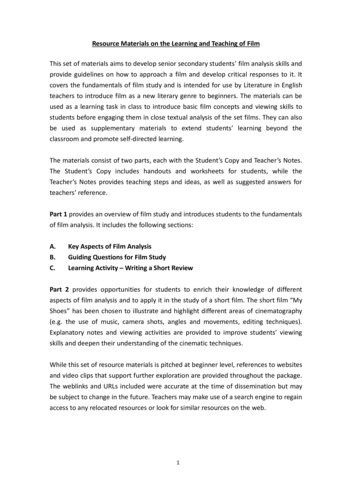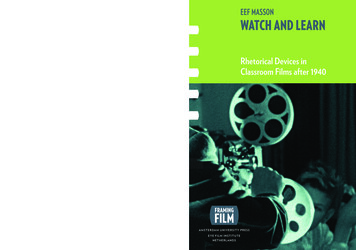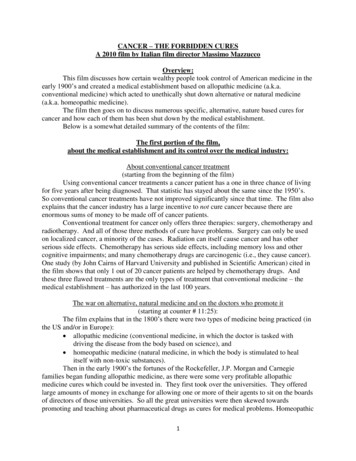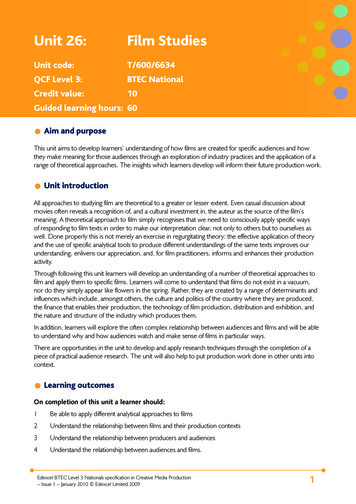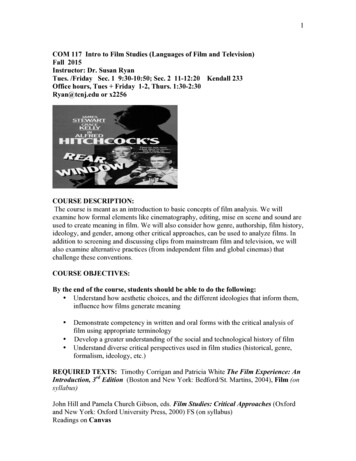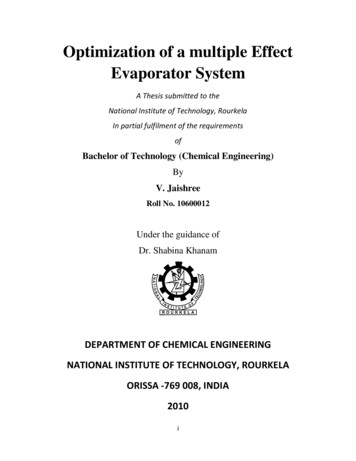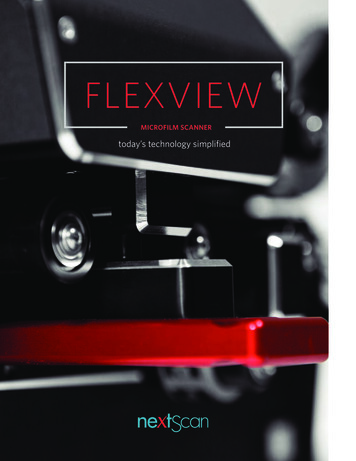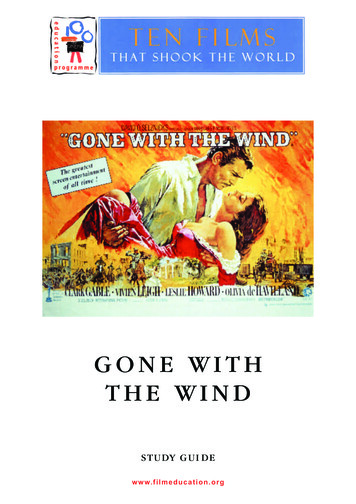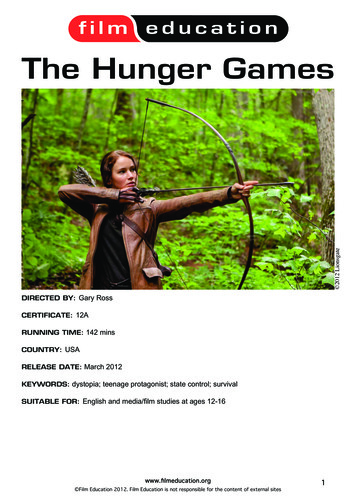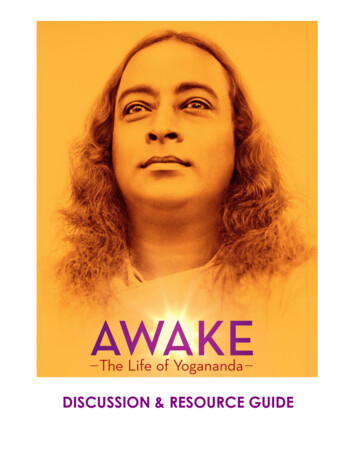
Transcription
DISCUSSION & RESOURCE GUIDE
Table of ContentsFilm SynopsisAbout the FilmmakersQ&A With the FilmmakersKey IntervieweesAbout Paramahansa YoganandaA Brief History of Yoga in the WestWhat is Yoga?Excerpts on Yoga from the Bhagavad GitaParallels Between Science and Religion on the Nature ofRealityDiscussion QuestionsSuggested ResourcesAWAKE: The Life of YoganandaCopyright 2015, Self-Realization Fellowship, Los Angeles, California, U.S.A.Photos of Paramahansa Yogananda courtesy of Self-Realization Fellowship. All rights reserved.www.awaketheyoganandamovie.com2
Film SynopsisAWAKE: The Life of Yogananda is anunconventional biography about an IndianSwami who brought yoga and meditation to theWest in the 1920s. This feature documentaryexplores the life and teachings of ParamahansaYogananda, who authored the spiritual classicAutobiography of a Yogi, which has introducedmillions of readers to the wisdom of the East. Ago-to book for seekers, philosophers and yogaenthusiasts today, it was the only book that SteveJobs had on his iPad, and he arranged to giveaway 800 copies of it to the dignitaries whoattended his memorial service. Autobiography ofa Yogi has also been a point of entry into Easternmysticism for George Harrison, Russell Simmonsand countless yogis. By personalizing his ownquest for enlightenment and sharing hisstruggles along the path, Yogananda madeancient teachings accessible to a modernaudience, attracting many followers andultimately helping millions of seekers today to turn their attention inwards, buckingthe temptations of the material world in pursuit of self-realization.Filmed over three years with the participation of 30 countries around the world, thefilm examines the world of yoga, modern and ancient, East and West. While archivalmaterial from the life of Yogananda (who died in 1952) creates a spine for thenarrative, the film stretches the dimensions of a standard biography, taking vinitySchoolanditscuttingedge physics labs, from the Center for Science and Spirituality at the University ofPennsylvania to the Chopra Center in Carlsbad, California.By evoking the journey of the soul as it pushes its way through the oppression of theego and delusion of the material world, the film creates an experiential immersioninto the unseen realms. AWAKE is ultimately the story of mankind itself: the universalstruggle of all beings to free themselves from suffering and to seek lasting happiness.www.awaketheyoganandamovie.com3
About the FilmmakersPAOLA DI FLORIO (Director)Paola di Florio is an award-winning, Oscar-nominatedfilmmaker and television producer whose work hasfeatured extraordinary individuals and the triumph of thehuman spirit. Among her other films are Speaking inStrings and Home of the Brave. Her television workincludes producing a TV series for Canal Plus entitledDirectors on Directors. She is also a founding partnerof Nerd Girls, Inc., a New Media startup dedicated tocreating new role models and empowering young womento enter the fields of science and engineering.LISA LEEMAN (Director)Lisa Leeman has directed, written and produceddocumentaries for the last 25 years, including One LuckyElephant, Out of Faith, and Crazy Wisdom: The Life and Times ofChogyam Trungpa. Her groundbreaking first film,Metamorphosis: Man into Woman,wontheFilmmaker’sTrophyat the 1990 Sundance Film Festival. Other honors include anEmmy nomination and the once-in-a-lifetime American FilmInstitute Independent Filmmaker Grant. PETER RADER (Producer)Peter Rader has worked as a film and televisionwriter/director for more than 20 years. His first script,Waterworld, was produced by Universal, and he hasdeveloped numerous projects for such industry leadersas Steven Spielberg and Dino Di Laurentiis. He workedas a cinematographer on a number of award-winningdocumentary projects. Rader also directed episodes ofthe hit nonfiction TV show Dog Whisperer with CesarMilan. His biography Mike Wallace: A Life was workingon a second book to be published by Simon & Schuster.www.awaketheyoganandamovie.com4
Q & A with DirectorsPaola di Florio & Lisa LeemanQ: How did your film come to be?Paola & Lisa: Yogananda’slegacyorganization,Self-Realization Fellowship, hadbeen approached for decades by people wanting to make a film about the Guru whobrought Yoga to the West. For one reason or another, the time never was right. In2008, however, an opportunity presented itself with financing through ssingonanditseemedtherightmoment to make a film. SRF decided to find a team of independent filmmakers ve search and we were fortunate to have been selected to make the film. Ofcourse, right after being hired, we looked at one another and realized we had adaunting task before us! Not only was it an epic story, but it would also challenge us,the filmmakers, to distill these ancient teachings in a user-friendly form foruninitiated ftheresponsibility,because it would have been way too intimidating.Q: What was the most challenging thing about making this film?Paola & Lisa: Therewerealotofchallenges!It’snoteasytomakeafilm about et,’and while we found certain provocative allegations along the way, there wasnothing to back them up. As we dug deeper into his life, however, we discoveredthat he faced major obstacles, many of which the public was nandacametothestrangelandofAmerica in 1920 to disseminate an ancient teaching that had parallels to theEinsteinian physics of the times. Indeed, these yoga meditation teachings would beseen as essential tools for human beings to survive the atomic age. Despite beingrecognizedasa“spiritualgenius,”Yogananda would face severe criticism and evenracism in the deep South, from those who felt threatened by him and his message.Persecution, betrayals by students and close friends, and even financial ruin ensued.www.awaketheyoganandamovie.com5
He was continuously tested. But Yogananda rose like a phoenix through the ashes ofhis demise, not only to regain his own purpose in life, but to inspire others to do thesame through his example. There were times, however, when Yogananda wanted torunoffandbeahermitinaHimalayancave whichishow we felt sometimes as weapproached the challenge of digging through hundreds of files and reels of archivalmaterial, and studying the voluminous spiritual teachings Yogananda left behind,distilling them to something understandable (first to us, and then to an audience). Attimes, we downright wrestled with it. It took us quite awhile to digest andinternalize these concepts, and to figure out how to convey them in a cinematic way.We experimented with creating internal states of consciousness through cinematicmetaphor, as it was of utmost importance to us that the film be experiential, notmerely informational, and that we invite viewers on a journey of deeper awarenessand possibility through the filmmaking.We decided to have Yogananda tell his story through his own words (rather thanusing a third person narrator), in an effort to create more intimacy. This meant that,in addition to using some audio recordings of Yogananda, we had the privilege ofcasting a brilliant, prominent Bollywood star, Anupam Kher, to read his words paliveasenseofmagicalrealismthat Yogananda created when writing Autobiography of a Yogi, where herecounted intimate moments of a life that is well beyond the mundane. We alsocreated measured pacing in moments where viewers could come in and out efromtheintellectandallowingthem justto“be.”Q: What do you think audiences will appreciate about your film?Paola & Lisa: We hope the film will place Yogananda in the context of his times,allowing for greater understanding of the history of Yoga in America and what thispractice is really all about. But most importantly, we wish for the film to spiritualjourneys,andperhapshelp plant a seed to take them even deeper. We want to inspire viewers to becomeAWAKE.Q: What type of experience do you hope the film will bring to viewers?Paola & Lisa: Yogananda frequently used the ocean as a metaphor forconsciousness, a concept people who spend a lot of time in the water seem to realizeintuitively. We use a lot of water imagery in the film. Yogananda compared theindividual self to waves of the ocean, which take form, and then merge back with theone field that unites us all, the ocean of consciousness.www.awaketheyoganandamovie.com6
Key Interviewees in Order of Appearance(A Partial Listing)Ravi Shankar – The most celebrated sitar player in theworld, he has achieved worldwide acclaim as one of theforemost composers and teachers of Hindustani music.Krishna Das – One of the best-selling western artists ofIndian chant music, he has made kirtan accessible toWestern audiences around the world.George Harrison – Former Beatle and life-long meditator,his apprenticeship with Ravi Shankar helped to introducesacred Indian music to the world.Bikram Choudhury – Disciple of Bishnu Ghosh,Paramahansa Yogananda’syoungerbrother,he founded theworldwide Yoga College of India, and Bikram Yoga.Francis Clooney S. J., Ph.D. – A professor of comparativetheology at Harvard Divinity School, he has writtenfavorable commentaries on Yogananda’s interpretations ofthe Christian Gospels.Varun Soni, Ph.D. – Dean of Religious Life at mostrecently, of Natural Mystics: The Prophetic Lives of BobMarley and Nusrat Fateh Ali Khan (Figueroa Press, 2014).www.awaketheyoganandamovie.com7
Brother Vishwananda – A monk of Self-RealizationFellowship for more than 40 years, he began his monasticlife at the Yogoda Satsanga Society of India ashram inRanchi, siteofYogananda’soriginalschoolinIndia.Hesits on the Board of Directors of both organizations.Deepak Chopra, M.D. – A leading pioneer of theholistic health movement and author of more than 65books on healing and spirituality, he is the founder of theChopra Center for Well Being in La Jolla, California.Sri Daya Mata – One of the first women in modernhistory to head a worldwide religious movement, sheserved as President of Self-RealizationFellowship/Yogoda Satsanga Society of India(SRF/YSS) for more than half a century, until her passingin 2010.Philip Goldberg – Author of American Veda: How IndianSpirituality Changed the West, he has written aboutpsychology, human potential and holistic health, andconducts lectures and workshops around the world.Anita Goel, M.D., Ph.D. – A Harvard-MIT-trainedphysicist-physician, Dr. Goel is a globally recognizedleader in the emerging field of nanobiophysics andfounder of Cambridge, MA-based Nanobiosym.Brother Chidananda – a Self-RealizationFellowship monk for more than thirty-five years, esident Sri Mrinalini Mata to oversee the publicationof Yogananda’s writings. He is also a member of the SRF/YSS Board of Directors.www.awaketheyoganandamovie.com8
Russell Simmons – Successful business entrepreneurand co-founder of Def Jam Records, he is also a bestselling author, and long-time practitioner of Yoga.Felicia Tomasko, R.N. – president of Bliss Network, andeditor-in-chief of LA YOGA, she is on the board ofdirectors of the California Association of AyurvedicMedicine and the National Ayurvedic Medical Association.Stefanie Syman – Journalist and author of The SubtleBody: The Story of Yoga in America, she is also a pioneer indigital media and practitioner of Ashtanga Yoga.Andrew Newberg, M.D. – a neuroscientist and pioneerin the neurological study of religious and spiritualexperience, and author of How God Changes Your Brain,he is the Director of Research at the Jefferson MyrnaBrind Center of Integrative Medicine and a physician atJefferson University Hospital.Robert Love – author of The Great Oom: The ImprobableBirth of Yoga in America, Love is an adjunct professor ofjournalism at the Columbia University Graduate School ofJournalism.Brother Anandamoy – A direct disciple of ParamahansaYogananda, he has been a part of the SRF monasticcommunity for more than 60 years and has lectured allover the world on Yoga and meditation.www.awaketheyoganandamovie.com9
Richard Wright – The older brother of former retary during his return trip to India in 1935-36.Sri Mrinalini Mata – A direct disciple of ParamahansaYogananda, she serves as president of SRF/YSS as well aseditor-in-chief of SRF publications. A member of the SRFmonastic community for nearly 70 years, she waspersonally trained by Yogananda to prepare hismanuscripts and talks for publication after his passing.www.awaketheyoganandamovie.com 10
About Paramahansa Yogananda(1893-1952)Paramahansa Yogananda was born Mukunda Lal Ghosh on January 5, 1893, inGorakhpur, India, into a prosperous and devout Bengali family. From his earliestyears it was evident to those around him that his awareness and experience of thespiritual was far beyond the ordinary.As a youth he sought out many of India's saints and philosophers, hoping to find anillumined teacher to guide him in his spiritual quest. In 1910, at the age of 17, in theholy Indian city of Banaras, he met the illuminated sage destined to be his teacher:Swami Sri Yukteswar, in whose Serampore hermitage he spent the better part of ng.AftergraduatingfromCalcuttaUniversity in 1915, he became a monk of India's venerable monastic Swami Order,and received his monastic name Yogananda (signifying bliss, ananda, through divineunion, yoga). Sri Yukteswar further bestowed on him the highest of all spiritual Sri Yukteswar had intimated more than once that Paramahansaji would travel to theWest to teach the ancient science of Kriya Yoga. (Kriya consists of definite, scientificmethods of meditation that deal directly with energy and consciousness, enablingone to perceive glimpses of the ultimate goal—conscious union with Spirit.)In his Autobiography of a Yogi, Yogananda recounts a visit he received from therenowned uYukteswarataKumbhaMela;ItoldhimthenIwouldsend you to him for training. Kriya Yoga, the scientific technique of awaketheyoganandamovie.com 11
Yogananda first set foot in America in 1920, as the Indian delegate to anInternational Congress of Religious Liberals convening in Boston, Massachusetts,and delivered a speech on thescience of religion. His arrivalmarked the beginnings of aprofound impact on thereligious landscape of the Westand the introduction of yogameditation to the westernworld. He established hissociety, Self-RealizationFellowship, that same year.Five years after his arrival inAmerica, Yogananda took upresidence in Los Angeles,At the Congress of Religious Liberals, Boston, MA 1920.California where, in 1925, heestablished an international headquarters for his society. Over the next decade hetraveled and lectured extensively, speaking to capacity audiences in major citiesthroughout North America and in England. To the tens of thousands of Westernerswho aughtbyBhagavanKrishna”werearevelation.Hundreds of thousands received from him personal instruction in his Kriya Yogateachings.Many prominent figures in science,business, and the arts became hisstudents, including horticulturistLuther Burbank, operatic sopranoAmelita Galli-Curci, George Eastman(inventor of the Kodak camera), poetEdwin Markham, and symphonyconductor Leopold Stokowski. In1927, Yogananda was officiallyreceived at the White House byWith British Diplomat John Balfour in front of The WhitePresident Calvin Coolidge, who hadHouse in 1927, (after meeting with President Calvinbecome interested in the newspaperCoolidge, who is looking out of the window).accounts of his activities. And, nearlya decade later, during a return tripto India in 1935-36, Yogananda met d Gandhi and several of his followers in Kriya Yoga.In June of 1935, Yogananda departed for his trip to India, which included stops inthe U.K. and Europe, including to Germany where he met with the great Christianmystic and stigmatist, Therese Neumann.www.awaketheyoganandamovie.com 12
Returning to the U.S. in late 1936, Yogananda decided that the time had come forhim to withdraw somewhat from public lecturing and he began to devote himself tohis writings, through which he would be better able to reach those who hadexpressed interest in deeper study ofhis teachings. In his seaside hermitagein Encinitas, California, which today isa retreat and ashram center, hebrought forth such spiritual classics asAUTOBIOGRAPHY OF A YOGI, and workedon his profound commentaries on thescriptures of East and West.During this time he also focused onestablishing Self-RealizationFellowship temples and meditationcenters, and building a firm foundation for the future of his spiritual an work. Under his direction,the personal guidance and instruction that he had given to students of his classeswas arranged into a comprehensive series of lessons for home ingonenessofall life, that we areintegral parts of a universal whole, and that each one of us can transform that visionof harmony from an intellectual possibility into direct personal experience of theone Reality that unites and sustains us all. His teachings embody a completephilosophy and way of life, of which meditation is the foundation.Autobiography of a Yogi,Yogananda's life story, waspublished in 1946 and expandedby him in subsequent editions.Recognized from the beginning asa landmark work in its field, thebook has been in printcontinuously since its initialpublication more than sixty-fiveyears ago and has been translatedinto more than 30 languages.His highly acclaimed commentaries on the scriptures of East and West – The SecondComing of Christ: The Resurrection of the Christ Within You and God Talks WithArjuna: The Bhagavad Gita – provide readers with the deeper meaning of theteachings of Jesus Christ and Bhagavan Krishna, and the underlying unity of theiruniversal truths.www.awaketheyoganandamovie.com 13
Paramahansa Yogananda passed away on March 7, 1952, in Los Angeles, followinghis delivery of a speech at a banquet honoring Dr. Binay R. Sen, India's Ambassadorto the United States. His passing received widespread coverage in the press.In 1977, on the occasion of the twenty-fifth anniversary of ParamahansaYogananda's passing, the Government of India formally recognized his outstandingcontributions to the spiritual upliftment of humanity, by issuing a commemorativestamp in his honor.Throughout his life ministry, Yogananda worked tirelessly to awaken people to therealization of their own divinity. Today, his society, Self-Realization Fellowship(www.yogananda-srf.org), has grown to more than 600 centers around the world,and his many writings and teachings continue to inspire millions of truth-seekers allover the globe.***www.awaketheyoganandamovie.com 14
A Brief History of Yoga in the WestParamahansa Yogananda was born during the height of the "British Raj," or colonialperiod in India. Though certain thinkers like the Transcendentalists in New Englandwere beginning to explore Eastern philosophy and thought, the interest had beenlargely limited to scholars and academics. In 1893, the year of Yogananda's birth, afellow Bengali, Swami Vivekananda, became the first Hindu Swami to address anAmerican audience at the Parliament of the World’s Religions in Chicago, a’sphilosophyandscienceofthe soul.As the century turned, breakthroughs in science would also pave the way for greateracceptance of the Hindu ontological paradigm. Albert Einstein published his GeneralTheory of Relativity in 1916, setting the stage for the birth of Quantum Mechanics,which radically altered our understanding of subatomic matter, suggesting theworld was not as solid as it is seemed to be, a cornerstone of Hindu philosophy.In the years leading up to Yogananda's voyage to America at age 27, the West hadbeen mired in World War I. With some 16 million casualties,it had been dubbed the "War to End All Wars," leavingpeople disillusioned and in search of new answers. In 1919,the year prior to Yogananda's arrival in Boston, Einstein'sRelativity Theory had been corroborated by an astronomicalobservation of a solar eclipse, in which the light rays fromdistant stars were recorded as "bending" under the influenceof gravitational forces. The year of his arrival in 1920 alsomarked the beginning of Prohibition in the UnitedStates. Despite the ban on the sale of alcoholic beverages, theperiod was marked by a gaiety and exuberance embodied bythe"Flappers." The decade ended on an entirely differentRobert Oppenheimer,U.S. Dept. of Energy, 1944.note, however, with the stock market crash of 1929 andwww.awaketheyoganandamovie.com 15
subsequent Great Depression. Meanwhile, in 1933 Adolph Hitler seized power inGermany and began mobilizing support for his Third Reich. By 1939, Europe wascaught up in another war, which the United States entered several years later. As thestakes increased in World War II, American scientists focused on developing theatomic bomb in a secret program dubbed "TheManhattan Project," under the supervision of physicistRobert Oppenheimer. U.S. forces deployed two nuclearbombs on Hiroshima and Nagasaki, during the finaldays of the war in August, 1945, while ParamahansaYogananda was writing Autobiography of a Yogi, whichhe published the following year.After the war, Great Britain helped in establishing thestate of Israel and also granting India its independencein 1947, under the stewardship of Mahatma Gandhi,who was assassinated the following year by anextremist gunman. Some years later, Yoganandaenshrined a portion of Gandhi's ashes at the SelfRealization Fellowship Lake Shrine inYogananda with California’sLt.GovernorandMrs.Pacific Palisades, California. YoganandaGoodwin J. Knight at the dedication of Self-Realizationdied in 1952, after reading his poem, "MyFellowship Lake Shrine and Mahatma Gandhi WorldIndia," to a banquet hall full of dignitaries,Peace Memorial, 1950.including India's ambassador to theUnited States.Among the earliest evidence ofWesterners’interestinYogacomesfrom the transcendentalists in themid-1800s, primarily Ralph WaldoEmerson and Henry David Thoreau.Among their essays and poetry areideas and perspectives which clearlymirror those found in the Vedic textsand the Yoga Sutras.In November of 1857, Emersoncontributed a poem entitledYogananda at theBiltmoreHoteltohonorIndia’s“Brahma”– a meditation on theAmbassador to the United States, s beings,andworlds”– to the inaugural issue of The Atlantic Monthly.Henry David Thoreau, also an early student of Eastern philosophy and commonlycited as America's first yogi, said of the text: "In the morning I bathe my intellect inthe stupendous and cosmogonal philosophy of the Bhagavad-Gita. in comparisonwith which our modern world and its literature seems puny and trivial."www.awaketheyoganandamovie.com 16
Other groups of Americans that began to show interest in Hinduism by the midnineteenth century included the American Oriental Society in 1842, and theTheosophists in the 1870s.It might be interesting to note that around this same time, as the early BostonianTranscendentalists (most of whom were Unitarians) and others began theirexploration of Hinduism and Yoga, a spiritual renaissance was taking place in India,marked by the historic meeting between the great saint Mahavatar Babaji and hisdisciple Lahiri Mahasaya, which would result in the revival of the sacred science ofKriya Yoga to the wing interest in Yoga philosophy. SwamiVivekananda, one of the foremost disciples United States to participate in the Parliament of theWorld’s Religions convening in Chicago. His talk libleimpressionontheparliament’sattendees.It was in this same year that in northern Indiaanother influential messenger of Vedic philosophywas born – Paramahansa Yogananda, who wouldlater be instructed by his line of spiritual teachers tobring the ancient philosophy and science of KriyaYoga to the West.Swami VivekanandaIn his book American Veda (Harmony Books, 2010) authorPhilip Goldberg traces the growth of interest in Vedicphilosophy and practice in modern-day America. He nda’sascendancy, other proponents of Indian spirituality addedcontributions of their own, like the builders of minorstructures surrounding the work of illustrious architects.Swami Rama Tirtha, a math-professor-turned-monk 902-4,but attracted a number of followers, mainly in the Bay Area;his writings would inspire later gurus, notably SwamiSevananda mBengalito English. Another 1902arrival, a former journalist named Paramananda Bahrain, was the first guru to offerAmericans a devotional form of Hinduism. Linked to the same lineage that wouldgive us the Hare Krishna movement in the 1960s, Bahrain stayed for nine years,teaching in New York and Los Angeles, and left behind a book, Sri Krishna: The Lordof Love, which was recently reissued. Perhaps the first teacher from India towww.awaketheyoganandamovie.com 17
promulgate Hatha Yoga for physical health, Shri Yogendra worked with New Yorkmedical researchers to establish the scientific credibility of the system; he stayed inthe United States from 1919 to 1924, then carried on his Yoga research in Bombay.But the best-known voice of India at the time was Rabindranath Tagore, the firstAsian to win theNobelPrizeforliterature .With his erudite passion and his abilityto blend Vedantic messages and poetic images, he did much to legitimize IndianphilosophyinthemindsofeducatedAmericans pagators addedtothewestward flow of Vedanta-Yoga, but they were minor tributaries compared to thetorrent that was Yogananda. He arrived three years after the First World War andtaught through the Roaring Twenties, the Great Depression, the New Deal, WorldWar II, the dawn of the Cold War, McCarthyism, and the Korean conflict. When hisboat docked in Boston, America was a nation of trains, farmers, and newspapers; 1952presidentialcampaign, it had become a nation of cars, consumers, and TV viewers. It had ictidalwave.”www.awaketheyoganandamovie.com 18
What is Yoga?Yogameans“union”– of the individual consciousness or soul with the UniversalConsciousness or Spirit – and consists of a philosophy and system of techniquesthrough which one can attain union with Spirit. Yoga is a simple process of reversingthe ordinary outward flow of energy and consciousness so that the mind becomes adynamic center of direct perception—no longer dependent upon the fallible sensesbut capable of actually experiencing ownasSanatana Dharma (literally,Eternal Truth), which encompasses the entire body of Vedic teachings. The religioncame to be called Hinduism when the Greeks, who invaded northwestern Indiaunder Alexander the Great, designated the people on the banks of the river Indus as“Indoos,”orHindus.The ancient rishis of India, literally seers, were the authors ofthe Vedas, in which (in the Upanishads) the doctrinal basis of the Hindu religion issummarized. Today, Hindus still refer to Hinduism as Sanatana Dharma. Yoga,because it is a science of religion, is universal and applicable within any rcesaboutYogaisIndia’sbelovedscripture, the Bhagavad Gita, which takes the form of a sacred dialogue betweenBhagavan Krishna (both an earthly king and divine incarnation) and his chiefdisciple, the Pandava prince Arjuna, and focuses on the universal battle between thesoul and the ego, and the Yoga path to liberation.The science of Yoga offers a direct means of stilling the natural turbulence ofthoughts and restlessness of the body that prevent us from knowing what we reallyare. By practicing the step-by-step methods of Yoga—taking nothing for granted onemotional grounds or through blind faith— the yogi comes to know his or heroneness with the Infinite Intelligence, Power, and Joy which gives life to all oganandamovie.com 19
In past centuries many of the higher techniques of Yoga were little understood orpracticed,owingtomankind’slimited knowledge of the forces that run the universe.But today scientific investigation is rapidly changing the way we view ourselve
AWAKE: The Life of Yogananda is an unconventional biography about an Indian Swami who brought yoga and meditation to the West in the 1920s. This feature documentary explores the life and teachings of Paramahansa Yogananda, who authored the spiritual classic Autobiography of a Yogi, which ha
